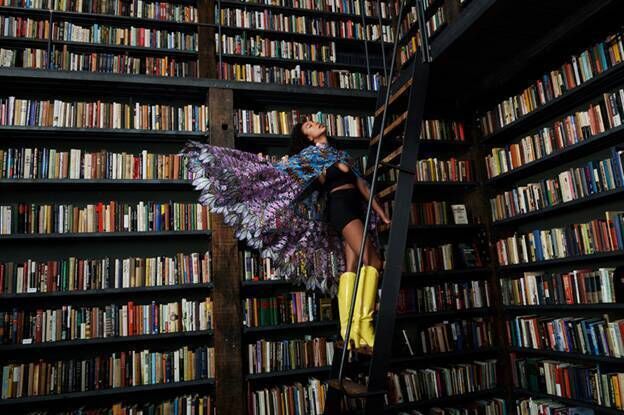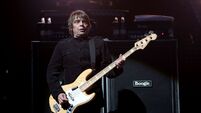Corinne Bailey Rae on her new direction and her gig at Cork Jazz Fest

Corinne Bailey Rae: breaking away from convention on her newest LP.
Corinne Bailey Rae was bored. Beginning with her 2006 hit single 'Put Your Records On' and across the three acclaimed albums that followed, the chart-topping soul-singer had delved deep into a wellspring of personal triumph and tragedy (the latter including the death in 2008 of her first husband).
But having spent so long inside her head, she felt it was time to turn to the wider world — a place beyond the four walls of her immediate lived experience.
From out of that thought process came her remarkable new record, — an effervescent mash-up of jazz, indie, electronica, and Afrofuturism.
“Maybe everybody gets to that point as an artist where they’ve had enough of themselves,” says the singer, ahead of a long-awaited performance at Guinness Cork Jazz Festival at City Hall on Sunday, October 29.
“That’s when people start making stuff up. Or you get those projects where someone has made a whole album about how hard it is to be on tour — all those lonely hotel rooms. They’re not necessarily things everyone can relate to, and it always seems a bit spoiled. But what other experiences are you having at that particular point? It was so refreshing to 'be' other people’s stories — other stories I was drawn to."
The catalyst was visiting a groundbreaking museum and archive chronicling the African-American experience on the southside of Chicago.
Stony Island Arts Bank was founded by artist Theaster Gates, the son of a roofer and teacher who had grown up in a historically deprived west of the city.
Ten years ago, he acquired the former Stony Island bank building, built in 1923, and transformed it into a living memorial to black America. Stepping over the threshold for the first time, Bailey Rae was smitten.
The Stony Island archive bears witness to the triumphs and challenges confronting black musicians and artists: for instance, it contains the entire recorded catalogue of house musician Frankie Knuckles alongside anti-African American propaganda, which illustrates the depth of prejudices African Americans have historically faced.
The building is, above all, full of stories: it was here that Bailey Rae learned about Audrey Smaltz, a beauty queen from Harlem whose photograph inspired her recent single, 'New York Transit Queen'.

It’s quite a switch-up from the radio-friendly soul pop of her 2006 debut, , which saw her heralded as an heir to Billie Holiday, Norah Jones, and Erykah Badu.
“I was excited about the stories before they were songs,” she says. “I wanted to know more about a beauty queen from the 1950s or a young woman hiding out on a plantation. Escaping slavery by hiding out until the coast was clear, for seven years. These were fascinating stories. My own interest led me to more reading, more research, more documents, more photographs. Each of these tiny details — sometimes they were fun or poignant or quirky… they were much bigger than my own life. It was fertile ground for taking moments of stories and setting them into song.”
Bailey Rae has achieved international success as a soul artist. Yet pop was not her first love.
In a previous life, she’d played in abrasive indie bands around her native Leeds.
She returns to that sound on new tracks such as 'Erasure', where her expressive voice is paired with caterwauling guitars.
These moments are a revelation. It’s a cliche to describe music as cathartic, but that’s the effect achieved here and Cork Jazz audiences are in for a treat.
She contrasts the liberation she felt absorbing the stories at Stony Island with the angst she had gone through while making her previous LP, 2016’s , where she perhaps placed too much stock on the opinions of people around her.
“I had a hard time on my third record. I wrote twice, three times the number of songs that are on it. As I presented each one, it was like gladiators: thumbs up or thumbs down. ‘It’s beautiful… but it’s not the first single’. It was all about finding this magical song that would be a massive radio smash — that would bang on [BBC] Radio One, bringing everyone back to you.”
The longer you are away as an artist, the more pressure there is for a ‘big single’, she says: “I found that limiting. The music I wanted to come through was stifled by this requirement. I internalised it to such an extent that I would start a song and think ‘oh what’s the point of finishing this. It’s to slow, too weird, too obscure… it’s not universal enough’. I didn’t feel like myself as an artist at that point.”
Looking back, it’s obvious to her that she had tied herself in knots, trying to force a hit. Paradoxically, has given her some of the best reviews of her career: the New York Times praised how its songs “flaunt extremes: noise and delicacy, longing and rage”; Pitchfork heralded it as “renaissance”. The moment she stopped trying, all this incredible music came pouring out.
“You have to remove the idea that there’s a target at all,” she says. “I thought of this record as a side project: ‘It’s not even going to have my name on. I’m going to say it’s an art project’. It’s based on this archive in Chicago: nobody’s going to be saying, ‘where’s the hit?’ Because of that, I can do what I want. There are other times I’ve meddled with songs: I haven’t let them be. I might finish and think ‘right, now how can I make it shorter…?’ We’ve got to change the drums — I can’t be just that. It starts off as something classic and inspired and it ends up a big hotchpotch because you’re trying to second guess what it should be.”
The stories she discovered in Chicago greatly impacted Bailey Rae, whose father is from St Kitts in the Caribbean. Growing up in Yorkshire, the experiences of the black community had been relegated to cultural footnotes, she feels.
“The black Caribbean experience has an awareness of slavery. There’s also a desire in the black Caribbean experience in Britain to distance that. There is sometimes more of a focus on colonialism and post-colonialism. I remember first learning about slavery at school. I remember seeing that Brooks slave-ship diagram — how to pack in as many people [as human cargo for the transatlantic slave trade].
"It was taught very unconsciously in our school to the two or three black children in class. It was very shocking to us and presented in a very matter-of-fact way. That was the first time I realised my great-grandmother who was alive at the time, she wasn’t walking along the streets of St Kitts in a crinoline dress.”
She looks forward to sharing her journey with fans — and bringing her extraordinary new record to Cork. “I feel I’m playing with people who challenge me and support me,” she says.
She jokes that the sheer technical accomplishment of her backing ensemble has pushed her to be a better player: “I always want to be the worst musician in the band. That is the trick with a band: getting people much better than you.”
- Corinne Bailey Rae plays Cork Opera House on Sunday, October 29 as part of the Guinness Cork Jazz Festival. is out now.







